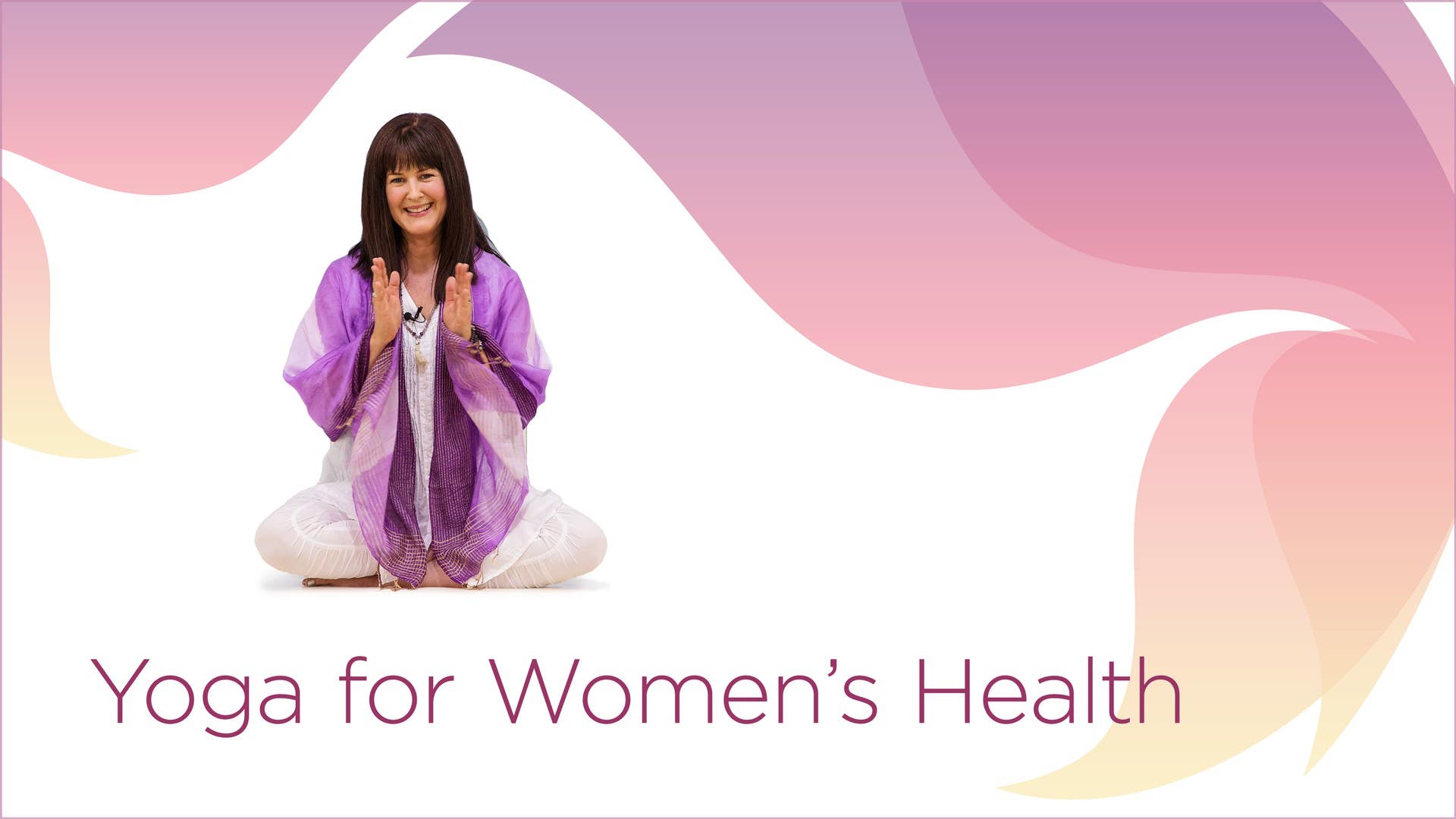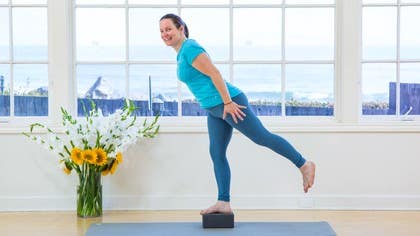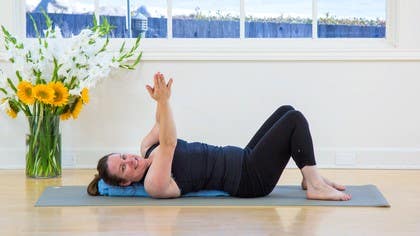Description
About This Video
Transcript
Read Full Transcript
Constipation is a pelvic health topic that not many people are talking about but lots of people experience at some time. And the reason why it's really important to address it is because constipation can lead to pelvic floor damage. So we want to prevent it as much as possible. Breath and movement are two of the main tools so that's why yoga really can help. First we'll start from standing here and before we get started you might want to have, and I'm sorry we have a lot of things, but I wanted you to have a lot of options here. We're gonna do some squat options so we have a ball, a blanket, bolster, chair, two blocks, and the wall. So all of those props are options and you can come back to this video and play it again when you want to try a different squat variation. So first we'll start from standing and do what's called the ILU massage or I love you massage. This is a great way to follow the track of the large intestine. Give yourself a little massage. You may have seen it with babies as well. We'll bring the hands just underneath the left rib cage and tracing downwards we make a straight line towards the left hip. So left rib cage to left hip, a little bit of pressure, just gentle pressure. Good and then we'll move across from the right rib cage over to the left rib cage. So we just follow along the rib cage, move over from the right, over to the left, and then down where we previously were. So this is the L part of it. So we move over and down. Amazing. A little bit of pressure but nothing that feels uncomfortable. And then moving the hands towards the right hip we're gonna move up from the right hip, up to the right rib, across to the opposite rib, over to the left rib, and then down to the left hip. So that's the U part. It's the U that's facing you. So we go up from the right hip to right rib, across to the left rib, and down to the left hip. We'll do that a couple more times. So this again follows the track of the large intestine. So we can also just make a circle then on the abdomen. So follows the track again. It's going in the same direction. We're going over from the right side to the left side. If you want you could tap your head as well, just for fun. And then another great way to get into a little twisting and breath and movement is to stand and sway. So we can bend the knees and sway. Continuous breath. Great. And then coming down to sit on a chair. If you have a chair, maybe you sit on the ball. I'll show that option as well. The chair feels like the most accessible way to do a squat. If squatting feels like it's not in your practice because of knee issues or maybe other contraindications are cervical concerns, placenta previa. If we feel like there's too much pressure down, if it's just uncomfortable in any way or if we're experiencing hemorrhoids, sometimes varicose veins or a contraindication, we need to check with the healthcare provider. So really any discomfort in squat, we don't want to come into a traditional squat, but we can access it on a chair. And if we sit at the corner of the chair and feel the sits bones into the chair, then this is a version of squat. If we wanted to place blocks underneath the feet and raise the feet up, we can. If we wanted to find a lower step stool, we could as well. That would work also. So we'll come to stand and then I'm just going to show you what it's like to use the ball in a few variations of squat. So obviously we can sit on the ball. That's one variation. Just sit towards the front and then come back to sitting on the ball. So this is a variation of squat as well. And this is a great one if we had any of those contraindications that I was listing before. We just don't feel like full squatting is what we want to be doing today. So we can sway around a little bit here. Another variation with the ball is to bring the ball up onto the wall, place the back against the ball, and sink down just to where the knees bend a little bit. So we have that kind of a cross between chair and squat. We feel supported in that. It can be a really great way to do chair as well. Another one is to bring the ball lower onto the floor. So this is getting more into the kind of more of a squat, traditional squat. And so the ball is there to support us. But if this feels like it's not going to work for the knees or too much pressure, then we can try another variation as well. But it's there and it's a little more support. We can lean back on it. Coming back up to standing. We'll find the blanket and the bolster. And place the blanket back behind the heels. So sometimes when we come into squat, we might need like say a sink at home is really helpful or a chair and to start to come down into a squat pose if this feels like it's accessible. Not to worry if you feel like not liking the squat. I have a delicious squat at the end that most people love. So we can start to lower down into squat and bring the bolster in. This one's a little tricky to get into. But we bring the bolster back behind the knees. And it's a delicious way to squat. This is one of my poses, my go-to poses, that I'm traveling and I feel like I am not going to the bathroom as regularly as I would like to. Which ideally in an ideal world would be 20 minutes after every meal. And so that's something to keep in mind. We'll slowly come out of this and I'm just going to show you from another angle. You can stay in it if you would like or wiggle around. If you don't have a bolster at home, you can also use a blanket behind the knees will work as well. Bolster seems to give a little bit more support. Hands can be wherever they want to be. You could also be holding on to something if you feel a little unsteady here. The blanket behind the heels really does help. And we'll slowly come out.
And come down to lying on the side. So here we get into the same the same versions of squat. We're gonna support the head either with a pillow or with the hand. Knees are bent. So in reclined Buddha here, it's the same thing as squat. We can support the head either with the pillow or the hand and hug the top knee and see how it's the same movement as a squat. So we're bending the knee and we have that hip flexion. Same thing there. So we can release the leg down, hug it in, focus on the breath. So when we lengthen the breath, that's another great way to help if we're feeling constipated. We might even try and inhale through the nose and exhale through pursed lips and we'll get ready to roll over to the other side. So again, support the head with the hand or a blanket or a pillow. We stack the knees here and we'll exhale, bending that knee. Inhale, we can lower it and we might exhale through pursed lips. That can help with the... I'm coming up to sitting, roll all the way onto our back and find knees hugged in. So bending the knees, planting the feet, and then when you're ready, either one knee hugged in at a time or both knees hugged in. We can rock a little bit side to side. So this is a lot like child's pose. That's another variation of squat. This one's a little friendlier for any knee issues that we might have. And if we want to play around here a little bit, we could come into half happy baby or full happy baby and rock a little bit, side to side. Lowering the legs down. We'll move into my absolute favorite version of squat against the wall. So rolling over, coming up to sitting, getting close to the wall. I like to sit as close as possible so that it's almost like you're sitting up on the wall. Don't worry if you're not right against the wall as we roll down. So we're gonna slowly extend the bottom arm out, bend the knees, bring the feet up onto the wall, and from here we're in squat pose. And if that feels like it's too much for the knees, we can just move the feet out further away from us or walk the feet in closer. Maybe the feet are closer towards each other or further away. Really find what feels comfortable. And why this is one of my favorite favorite squats is that the spine is in alignment. So we can find our ribcage breath, we can find ease, we maybe let the arms be heavy, let the hands be heavy, backs of the hands to the earth.
Find your breath here. And then slowly start to extend the legs up to straight. And we'll finish with legs up the wall unless it feels really delicious to stay in squat against the wall and you can throw our legs up the wall help with the circulation. Maybe the eyes close or they soften. See if you can relax your jaw, relax the face. Just that alone can help us if we're dealing with constipation. Lengthening the exhale can also help. You can stay here as long as you'd like to. We'll start to bring movement into the hands, into the toes, wiggle the toes. Start to bend the knees, rolling over to one side. I'm really taking your time because we've had our legs up the wall pressing with the hands into the floor and I like to then sit with the back right against the wall for support.
So thank you so much for sharing in this little different ways to do squats, different information about constipation. If you have any questions feel free to reach out to me and let me know how this goes and let me know how you go or don't. You don't have to put that in the comments. Namaste.
Yoga for Women's Health: Yoga For Pelvic Health
Comments
You need to be a subscriber to post a comment.
Please Log In or Create an Account to start your free trial.











